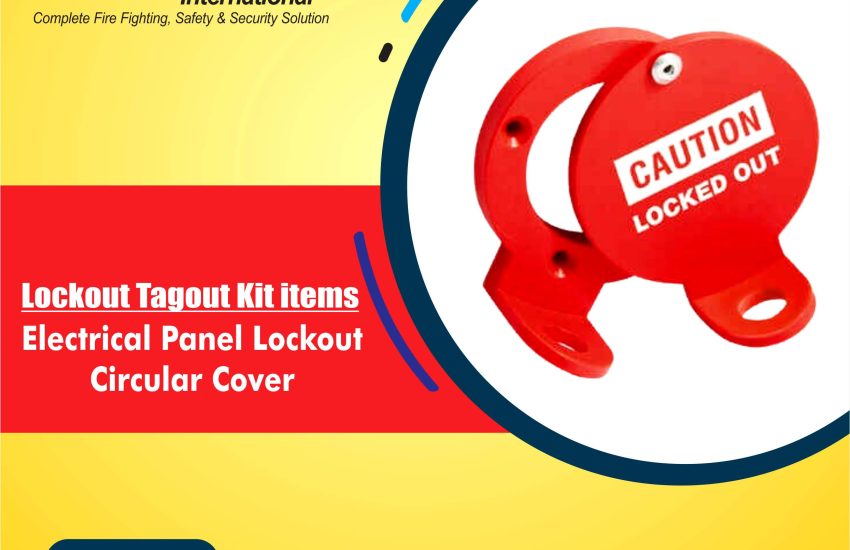Electrical Panel Lockout – Circular Cover Ensuring safety during electrical maintenance and repairs is crucial. Electrical panel lockouts are one of the most effective ways to protect workers from electrical hazards. Among these, the circular cover lockout stands out for its reliability and ease of use. This guide will cover everything you need to know about electrical panel lockout circular covers, including their benefits, how to use them, and their role in workplace safety.
What is an Electrical Panel Lockout Circular Cover?
An electrical panel lockout circular cover secures electrical panels during maintenance or repair. It prevents unauthorized access to electrical circuits, which reduces the risk of shocks, short circuits, or fatalities. The circular design fits easily over the panel’s opening, creating a secure barrier between the worker and live electrical components.
These covers typically consist of durable, insulating materials that protect workers from electrical hazards. They work well with other lockout/tagout (LOTO) devices to ensure complete protection.
Why Lockout/Tagout Procedures Matter
Lockout/tagout (LOTO) procedures are essential in industries that deal with hazardous energy sources, including electricity. OSHA (Occupational Safety and Health Administration) mandates these systems to control hazardous energy during maintenance work.
A circular cover lockout enforces these procedures by securing electrical panels and preventing accidental access. Using multiple lockout devices creates a comprehensive safety system, which reduces the risk of electrical accidents, injuries, and fatalities.
Benefits of Using Electrical Panel Lockout Circular Covers
- Improved Safety: Circular covers keep workers safe by preventing accidental exposure to live electrical components. This significantly reduces the risk of electrical shocks and injuries.
- OSHA Compliance: Using lockout devices like circular covers helps businesses meet OSHA regulations for controlling hazardous energy. This ensures that your workplace stays compliant.
- Durability: These covers withstand harsh conditions, offering long-lasting protection. They remain effective even in demanding environments.
- Easy to Use: Installing and removing the covers is simple and quick. Maintenance teams can work efficiently without compromising safety.
- Prevents Unauthorized Access: Workers can lock the cover in place with a padlock. This ensures only authorized personnel have access to the electrical panel.
How to Use an Electrical Panel Lockout Circular Cover
Follow these steps to maximize safety when using an electrical panel lockout circular cover:
- Locate the Electrical Panel: First, find the panel that needs maintenance.
- Turn Off the Power: De-energize all circuits in the panel. Always double-check that no live current remains.
- Place the Lockout Circular Cover: Position the cover securely over the electrical panel’s opening.
- Apply the Lock: Attach a padlock to the cover to secure it. Only authorized personnel should have access to the lock.
- Tag the Lockout Device: Attach a lockout tag with information like the worker’s name, the date, and the maintenance reason.
- Perform the Work: Proceed with maintenance or repairs, knowing the electrical panel is locked and secure.
- Remove the Lockout Cover: Once the work is done, remove the cover and restore the electrical system.
Other Electrical Panel Lockout Devices
Besides the circular cover lockout, several other lockout devices are commonly used:
- Breaker Lockouts: Lock individual circuit breakers to prevent them from turning on during maintenance.
- Hasps: These devices allow you to secure multiple devices or switches at once, providing a more thorough safety solution.
- Pushbutton Lockouts: These secure push-button switches, preventing accidental activation during maintenance.
- Switch Lockouts: These devices prevent electrical switches from being turned on while work is being performed.
Choosing the Right Electrical Panel Lockout Circular Cover
When selecting a circular cover, consider these factors:
- Size: Ensure the cover fits the electrical panel’s opening. Some covers are adjustable, while others are designed for specific panel types.
- Material: Look for covers made from durable, insulating materials like PVC or reinforced nylon. These materials offer protection against electrical hazards and environmental factors.
- Ease of Use: Choose a cover that’s easy to install and remove. A simpler design encourages workers to follow lockout procedures.
- Compatibility: Make sure the cover works well with other lockout devices, such as padlocks and hasps, for added protection.
Conclusion
Electrical panel lockout circular covers are essential for workplace safety. They protect workers from electrical hazards, ensure compliance with OSHA regulations, and prevent unauthorized access. By incorporating these devices into lockout/tagout procedures, companies can create safer environments for their employees.


